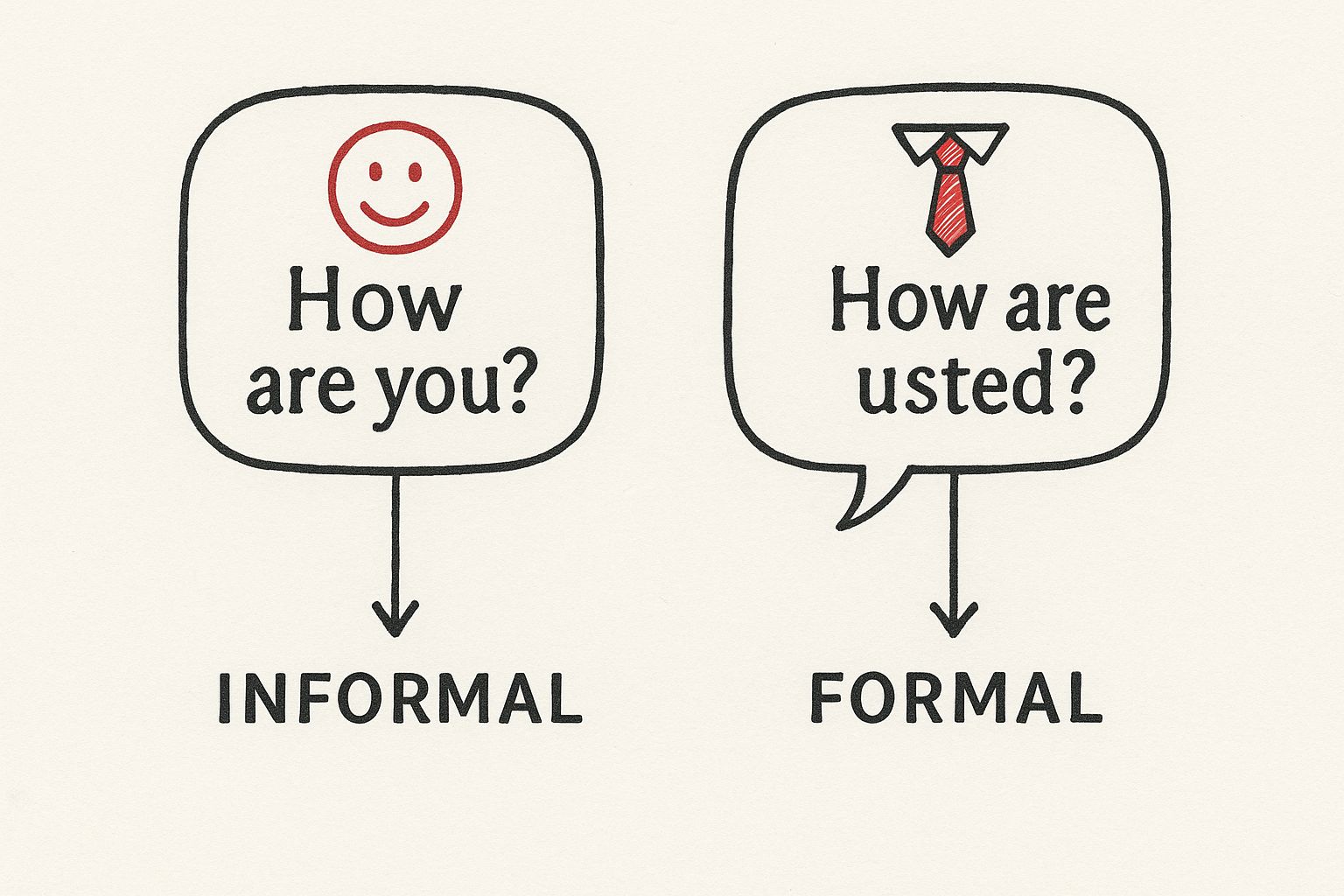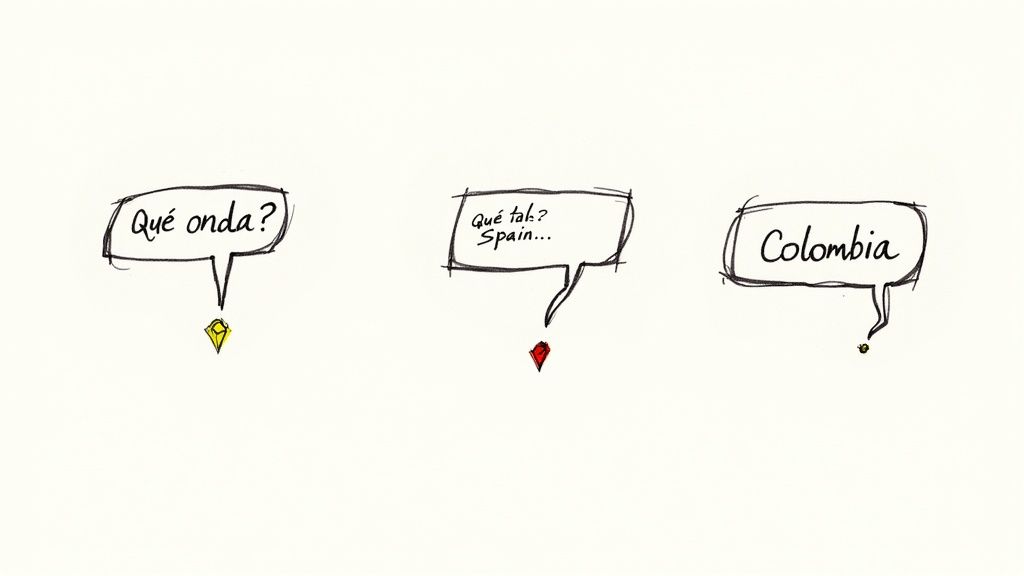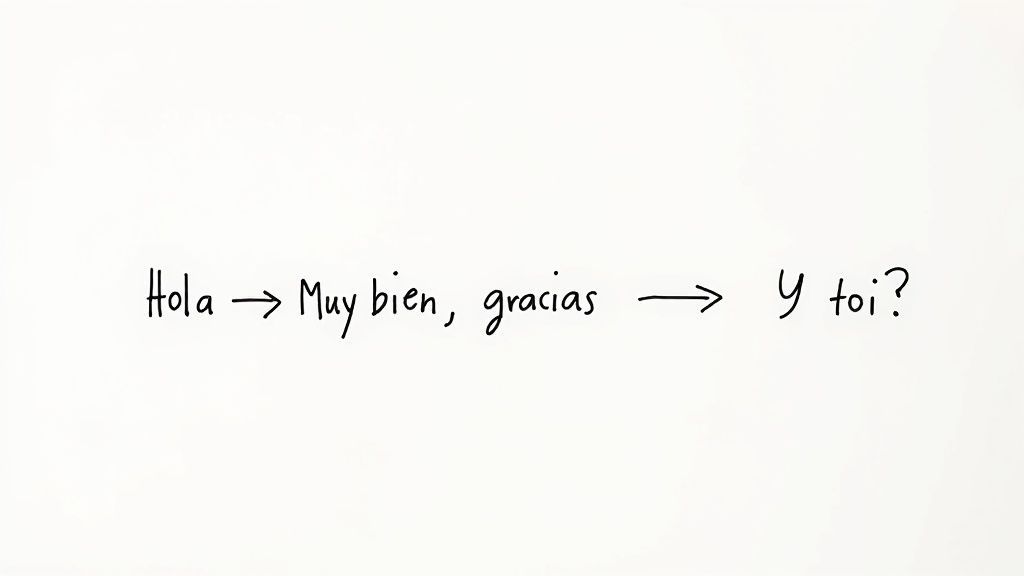How Are You in Spanish A Guide to Real Conversations
If you only learn one way to ask "how are you" in Spanish, make it ¿Cómo estás?. This is your go-to phrase and the perfect starting point, but the real key to sounding natural is knowing when to use it and when to switch to its more formal cousin.
The Most Common Ways to Ask How Are You in Spanish
Learning to ask "how are you" in Spanish isn't just about memorising a phrase; it's about getting a feel for the social cues behind it. The biggest difference you'll encounter is between formal and informal language. It's a bit like choosing between saying "What's up?" to a close friend and "How have you been?" to a new client.
Getting this right shows you respect the culture and the person you're speaking with, which goes a long way. With Spanish being the official language in 21 countries and spoken by around 496.6 million native speakers worldwide as of 2025, mastering these simple greetings opens the door to connecting with a massive global community.
Formal vs Informal Greetings
So, what's the difference? It all boils down to the pronouns for 'you': the informal tú and the formal usted. This choice changes how you conjugate the verb.
- Informal: ¿Cómo estás? (Use this with friends, family, kids, and anyone your age or younger).
- Formal: ¿Cómo está usted? (Reserve this for elders, authority figures, or people you’ve just met).
This simple visual breaks it down nicely:
The person you're talking to dictates the phrase you use. It's as simple as that.
In Spanish-speaking cultures, using the right level of formality is a clear sign of respect. Here's a solid rule of thumb: when in doubt, always start with the formal usted. The other person will usually let you know if it's okay to switch to the more casual tú.
To help you get a quick handle on these phrases, here's a handy table summarising the key differences.
Quick Guide to Spanish Greetings for 'How Are You?'
| Phrase | Formality | Best Used For | Pronunciation Tip |
|---|---|---|---|
| ¿Cómo estás? | Informal | Friends, family, peers, people younger than you. | Stress the 'o' in Cómo and the 'a' in estás. |
| ¿Cómo está usted? | Formal | Elders, strangers, authority figures, in business. | Stress the 'o' in Cómo and the 'a' in está. |
| ¿Qué tal? | Very Informal | Close friends and family. A bit like "What's up?". | Rhymes with "k-tall". It's quick and casual. |
| ¿Cómo te va? | Informal | Asking someone "How's it going?" in a friendly way. | The 'v' sounds like a soft 'b'. |
This table gives you a great starting point for navigating different social situations.
Nailing these greetings is a brilliant first step towards real conversation. If you're ready to move beyond the basics and start speaking with confidence, structured learning can make all the difference. You can see how to build these skills in our Spanish classes for adults. Getting this right from the start helps you avoid those slightly awkward moments and build better, more genuine connections with the people you meet.
Getting to Grips with Tú and Usted
One of the biggest hurdles for Spanish learners is figuring out the difference between the informal tú and the formal usted. Honestly, this is probably the most important step towards sounding natural and respectful. Getting it wrong is a classic giveaway that you're a visitor.
Think of it like this: in English, you have to decide whether to call someone "Bob" or "Mr. Smith." Choosing tú or usted sends a similar social signal. It shows you understand the relationship and the context of the conversation. Picking the wrong one can lead to some slightly awkward moments—you might come off as too buddy-buddy or, on the flip side, a bit cold and distant. This isn't just a grammar point; it's a key part of social etiquette.
When To Use Tú
So, when is it okay to be casual? You'll want to use tú when you're talking to people you know well or who are on your social level. It helps build a friendly, relaxed vibe.
- Friends and Family: This is the most obvious one. If you're close, it's tú all the way.
- Peers: Think colleagues, classmates, or just about anyone your own age.
- Children and Teenagers: This is the standard way to talk to anyone younger than you.
- Pets: That's right, even your dog gets the informal treatment!
Basically, if the situation feels relaxed and informal, tú is almost certainly the way to go.
When To Use Usted
On the other hand, usted is your go-to for showing respect and formality. It's essential in situations where you need to be a bit more polite and create a little professional distance.
A great rule of thumb is to use usted as your default when you meet someone for the first time, especially if they're older than you or in a position of authority. It's always better to be a little too polite than not polite enough. If they want you to switch to tú, they'll usually let you know.
This is the standard approach in professional environments or when dealing with officials. It's also how you should always address elderly people, as a sign of respect. When in doubt, just start with usted—it's the safest bet.
Nailing this distinction takes a bit of practice, but getting guidance from a pro makes a world of difference. The qualified native Spanish teachers in our network are fantastic at explaining these cultural details.
Sounding Like a Local: Casual and Slang Greetings
Alright, you’ve got the standard greetings down. Now for the fun part: learning to talk like you actually live there.
Ditching the textbook phrases for more casual, local greetings is the quickest way to sound natural and build a real connection. It shows people you've gone the extra mile to understand their specific culture, not just the language itself.
A fantastic, all-purpose phrase to add to your toolkit is ¿Qué tal?. Think of it as the Spanish equivalent of "What's up?" or "How's it going?". It’s a super common, friendly greeting that fits in almost anywhere, from bumping into a friend on the street to starting a chat at a café. It's a great go-to when ¿Cómo estás? feels a little too formal.
Diving Into Regional Slang
Spanish isn't a one-size-fits-all language; its slang is as diverse as its people. Just as a Londoner asks, "You alright?" while a Californian says, "What's up?", each Spanish-speaking country has its own unique flavour.
Here are a few popular examples you'll hear on your travels:
- Mexico: It’s all about ¿Qué onda? (literally "What wave?"). This is the classic, laid-back way to greet friends and is deeply embedded in Mexican slang.
- Colombia: You'll often hear the warm and friendly ¿Qué más?, which translates to "What else?". Don't let the literal meaning confuse you; it's used exactly like "How are you?".
- Argentina: A common casual greeting is ¿Cómo andas?, which means "How are you walking?". It’s a relaxed way of asking someone how life is going for them.
The Spanish-speaking world is huge. In a recent year, the global count of Spanish speakers was projected to pass 600 million, with about 210 million of them in South America alone. Embracing these regional phrases is your key to connecting with this vibrant global community.
Dropping a bit of local slang into your conversation is more than just a language trick. It’s a sign of respect and genuine interest that can turn a simple chat into a memorable connection.
If you really want to nail these phrases and get the pronunciation just right, listening and repeating is key. Using tools like Spanish Speech To Text software can be a massive help. It allows you to practise your speech and get instant feedback, helping you fine-tune your accent until you sound just like a local.
How to Respond Naturally and Keep the Conversation Going
You've nailed asking "how are you?" in Spanish, which is a brilliant start. But the real art of the conversation lies in what comes next: the reply. Your response is the bridge between a simple greeting and a genuine exchange.
Thankfully, you don't need a huge vocabulary here. Most of the time, a simple "Bien, gracias" (Good, thank you) is the perfect go-to. If you’re genuinely having a great day, you can dial it up to "Muy bien, gracias" (Very well, thank you). These are your trusty, all-purpose replies that fit everywhere, from a quick chat with a barista to greeting an old friend.
But what about those days when things are just… okay? We all have them. In that case, "Más o menos" (So-so) is a completely natural and common way to express that you're feeling a bit neutral.
Turning a Greeting into a Conversation
Here’s the most crucial tip: always return the question. Forgetting this is the conversational equivalent of dropping the ball. It can signal that you're not really interested in talking.
The secret to keeping the conversation alive is a simple follow-up. Use "¿Y tú?" (And you?) in casual chats or "¿Y usted?" (And you?) when you need to be formal. This tiny phrase makes all the difference, showing you're engaged and care about how the other person is doing.
Getting this back-and-forth rhythm down is what makes chats feel smooth and authentic. One of the best ways to get comfortable is to practise with real people. Joining some Spanish group classes for adults creates a relaxed space where this kind of conversational flow can become second nature.
Common Responses to '¿Cómo Estás?'
To make things easy, here’s a quick breakdown of common replies and the all-important follow-up question. Think of it as your cheat sheet for everyday Spanish greetings.
| Sentiment | Spanish Response | English Meaning | Follow-up Question |
|---|---|---|---|
| Positive | Muy bien, gracias. | Very well, thank you. | ¿Y tú/usted? |
| Neutral | Bien. | Good. | ¿Y tú/usted? |
| So-so | Más o menos. | So-so / More or less. | ¿Y tú/usted? |
Having these options ready will help you respond confidently and keep the conversation moving in any situation.
Don’t Just Translate—Connect: Cultural Tips and Common Pitfalls
So, you’ve got the phrases down. But just knowing the words isn’t the whole story. Asking "how are you?" in Spanish is often less about getting a detailed health update and more about performing a social ritual. It's the little dance we do before a conversation truly begins.
One of the most common stumbles for learners is oversharing. When someone asks how you are, a simple and positive "Bien, gracias" is usually the perfect reply. This isn't you being rude; it's you playing your part in the greeting perfectly. Unpacking your entire day’s struggles can catch people off guard, unless it's a close friend who is genuinely asking for the details.
Mind the Map: Regional Slang and Local Flavour
With nearly 500 million native Spanish speakers scattered across the globe, the language is anything but monolithic. From the streets of Mexico City to the plazas of Madrid, Spanish is a vibrant tapestry of dialects and local slang. You can get a better sense of this incredible diversity by checking out the global reach of Spanish speakers on rosettone.com.
What’s cool and casual in one country could be baffling—or even a bit rude—in another.
Here are a few classic mistakes you’ll want to sidestep:
- Mixing up your slang: A friendly "¿Qué onda?" is perfectly normal in Mexico, but it will probably get you a few blank stares in Spain.
- Getting the formality wrong: Sticking to the formal usted with someone your own age in a casual setting can sometimes feel a bit stiff and create an awkward distance.
- Forgetting the context: You’d use a casual "¿Qué tal?" with a buddy at a café, but it’s likely too relaxed for your first business meeting with a new client.
Think of it this way: you wouldn't greet your CEO with "What's up, dude?". The same logic applies here. The real skill is learning to read the room, listen to how native speakers talk to each other, and adjust your own language to fit in.
At the end of the day, it's all about respect. When you take the time to learn these unwritten rules, you’re doing more than just speaking Spanish correctly—you're showing that you care enough to truly connect with people.
Your Top Questions About Spanish Greetings, Answered
Once you’ve got a handle on the basic greetings, you’ll naturally start to wonder about the finer points. Let's clear up some of the most common questions that pop up, so you can walk into your next Spanish conversation feeling much more confident.
¿Cómo estás? vs. ¿Qué tal? – What's the Real Difference?
This is probably one of the biggest head-scratchers for new learners. Both translate to "How are you?", but they don’t feel quite the same.
Think of ¿Cómo estás? as your standard, reliable "How are you?". It's a direct and common way to ask someone how they're doing.
On the other hand, ¿Qué tal? is more like a casual "What's up?" or "How's it going?". It’s incredibly versatile and a bit more laid-back, making it a fantastic all-purpose greeting.
Greeting More Than One Person
So, what do you do when you’re walking up to a group of friends or colleagues? This is where the plural form, ¿Cómo están?, comes into play.
It's the go-to phrase for asking a group of people how they are. The great thing is that it works for both formal and informal situations. Whether you're greeting your best mates or a room full of business partners, ¿Cómo están? is the perfect choice. You don't have to stress about choosing between formal or informal when there's more than one person involved.
The key takeaway here is simple: if you see a group, just swap 'estás' or 'está' for 'están'. It's a small change that makes a big difference and helps you sound much more natural.
Is Just Saying 'Hola' Rude?
Let’s talk about greeting etiquette. Can you get away with a quick “Hola” and leave it at that?
In most Spanish-speaking cultures, just saying “Hola” can come across as a bit abrupt or incomplete. Think of it like a two-part handshake—the greeting itself is only the first half. It's almost always expected that you'll follow it up with a polite question.
- The Standard Move: Always try to pair your “Hola” with a follow-up like “¿Cómo estás?” or “¿Qué tal?”.
- Why It Matters: This simple addition shows genuine interest and warmth, turning a quick acknowledgement into a proper, polite start to a conversation.
Getting this habit down is a huge step in making your interactions feel more authentic and respectful. And for those of you who are passionate about teaching or sharing your knowledge, a great way to illustrate these points is through visual aids; you might even consider creating educational videos in Spanish to bring the lessons to life.
At Spanish Council Singapore, our native teachers guide you through exactly these kinds of cultural details so your conversations flow effortlessly. Check out our courses and start speaking with real confidence by visiting https://spanish.sg.















